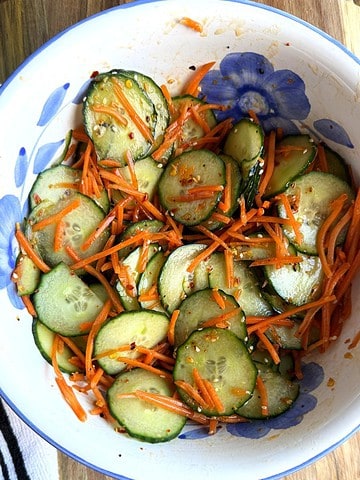When trying to stay on a budget, meal planning is essential to keeping your spending in line. Preparing an inventory of budget-friendly meals makes it easier to stay within a budget and meet your financial goals.
I’ve been on a journey to improve my finances for a few years now. As I’ve talked about in previous posts about financial success, I find budgeting to be extremely important. One area of my budget that I’ve been able to capitalize on is food spending. Don’t get me wrong, I LOVE food (and I think food is actually my love language), but I do not love spending a ton of money on food.
This page contains affiliate links to products I recommend. If you purchase something from this page, I may receive a small percentage of the sale at no extra cost to you. For more info, click here.
What we spend on food, groceries, and eating out can fluctuate so much each month if we don’t have a grasp of our budget. Today I want to share how meal planning can take the ups and downs out of our budget and build consistency in your spend to grow your wealth.
How can meal planning help my budget?
You may be asking, can sitting down once a week, planning my meals, and taking my lunch each day to work really improve my financial situation. The answer is undeniably yes. When I plan ahead, slow down and plan out my meals, I am able to not only spend less, but also experience other positives as well.
Did you know that according to the Bureau of Labor and Statistics, the average American household spends about $3,000 a month dining out. That’s WILD to me, and definitely not how I want to be spending my money.

The thing I love the most about meal planning is how much money I save. By meal planning, I’m not frantically running through the drive through at lunch or dinner time. I’ve already got something cooked, or all my ingredients organized to put my meal together. I’m not spending extra money on fast-food “convenience.”
I bring my lunch to work every single day. I have figured out that my lunch costs me between $2-5 each day. What would I be spending if I did not meal plan and had to grab something quick either at a drive-through or the grab-and-go section of the grocery store? I would spend at least $10. I work an average of 20 days a month, so if my math serves me correctly, eating out for lunch every day would cost me at least $200 a month. If I meal plan and bring my own lunch, I spend between $40 and $100 which is a savings on average of about $150 a month. $150 a month may not sound like much, but multiply that by 12 months and that’s a savings of $1,800. I don’t know about you, but $1,800 in my budget can do a lot of great things for my debt decrease or savings increase.
Using that same concept for dinner, I spend between $7-10 each evening for dinner for myself and my boyfriend. If we would go out to eat or grab take out? We’re spending a minimum of $25. Without meal planning, our budget would go up in smoke pretty quickly.
How I Meal Plan
While meal planning may seem intimidating, it really doesn’t have to be. In our household we follow the same process every week to set ourselves up for success.
- Write out our Entire Weekly Schedule & Check out the Weekly Sales
Every Sunday morning, my boyfriend and I sit down with our coffee, the weekly grocery ads and a planner. We write out our entire schedule--his football workouts, my yoga classes, any appointments we have, etc., and figure out who is home first each night. From there, we look at the grocery ads and figure out what is on sale for the week, and shop the sales. We have enough budget-friendly meals in our repertoire that we can usually make some pretty delicious, budget friendly meals based on what's on sale.
- Cook and Organize for Lunch & Breakfast
Once we get home from the grocery store, we begin to organize and prep to cook. We buy enough meat for the entire week for our meals which often looks like a pack of bacon, a couple two pound packages of chicken thighs or breasts, a steak or pork chops and ground beef. We try and cook up all the meat we would need for lunches on Sunday. So we cook half the ground beef and half the chicken.

Along with cooking our meat for lunches, we’ll also cook a couple cups of rice or potatoes or noodles and store those as well. We’ll often cook enough rice, potatoes or noodles that we have enough for our lunches and enough to add to our dinners at least once a week.
- Store
Instead of using individual storage containers for each day of the week, we just store everything in big glass pyrex containers like these ones. A lot of people love the black plastic containers with separate spots for each food item, but I prefer not to use plastic.
Either the night before, or in the morning before we leave for work, we assemble our lunches in similar glass containers. We also keep plenty of condiments on hand, and also buy some things every single week like spinach, cottage cheese, mushrooms, and fresh veggies like carrots, celery, onions and zucchini. Super easy and budget friendly.
- Dinner is Served
Similar to lunches, we try and prep a little bit. If we’ve cooked enough chicken on Sunday, that will save us some time on weeknights because we can just toss it in with some rice or noodles, add sauce and serve.
Examples of Budget-Friendly Plan-Ahead Meals
By grocery shopping on Sunday, and planning for the week, we are already setting ourselves up for success to stay on track with our budget. So it’s not as big of a deal to make our dinners ahead of time and reheat them each evening.
One thing we do, however, is keep our weekly schedule on our fridge with who is going where each day and evening, and we also track our nightly meals on that schedule. It stops us from running to grab take out or fast food which is so crucial to staying on budget.
We try and keep our meals pretty balanced meaning we try and have meat, vegetables and a carb of some sort so that we’re getting a decent and nutritional meal.
We have two meals that we eat nearly every week however, pork taco bowls with my dutch oven pulled pork recipe, and chicken, pea and pesto pasta.
Pork Taco Bowls
We love to use this dutch oven pork butt recipe to meal prep. If we don’t have a ton of time to prep, we will actually transition this recipe to the crock pot, and the pork cooks all day. All we have to do at night is shred the pork and add to salsa, rice and beans.
Chicken Pea and Pesto Pasta
Along with dutch oven pork butt, we also love this chicken, pea, and pesto pasta for an easy weeknight meal. This recipe is perfect for leftover chicken from lunch. We whip it up in less than 45 minutes and have a dinner that’s so full of flavor you would never guess it was so easy.
How do you meal prep? Are you looking for other ways to simplify your finances and grocery bill? Read these posts:





Comments
No Comments